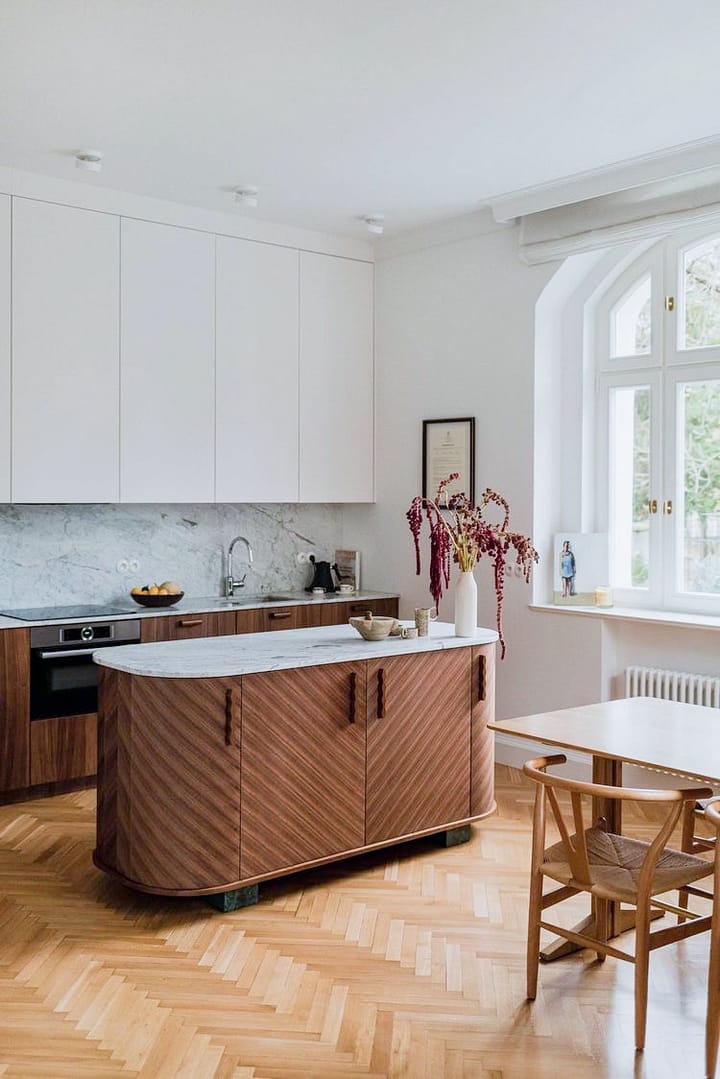Maximizing Small Kitchen Island in Compact Spaces

Did you know that a small kitchen can pack a punch with the right island?
According to a recent survey by Homes & Gardens, maximizing the functionality of compact kitchens has become a top priority for homeowners.
No matter the size, a well-designed kitchen can make a big impact.
Yes, islands aren’t just for sprawling kitchens; they can work wonders in tiny spaces too. Whether you’re dreaming of a space-saving breakfast bar or envisioning a moveable masterpiece, join us as we uncover the secrets to making the most of your petite kitchen space.

Let’s Start with Some Design Considerations, Ok?
Before we start, let’s ponder a bit.
In the reality of open-plan apartments and tight spaces, a small kitchen island on a single wall can be a game changer.
What do you want from your small kitchen island?
Is it extra storage, a cozy dining spot, or a multifunctional powerhouse?
Answering these questions will guide your design choices, ensuring your island is as functional as it is stylish.
Imagine a compact island multitasking as a prep zone, storage space, and even a breakfast bar.
*Affiliate Disclaimer.
This post may contain affiliate links, which means we may receive a small commission, at no cost to you,
if you make a purchase through a link.
What Are The Size Recommendations for a Small Kitchen Island?
When it comes to determining the size of your kitchen island, a thoughtful approach ensures both functionality and aesthetics.
The smallest kitchen island should ideally measure a minimum of 4 feet in length and approximately 2 feet in depth. However, it’s not merely about the dimensions; one must also factor in the need for ample space around the island. To ensure comfortable movement and efficient workflow, leave at least 3 feet of clearance space all around. In instances where more than one cook might be working simultaneously, a minimum of 48″ between the perimeter countertops and the kitchen island is advisable. It’s a delicate balance – achieving a size that complements the kitchen layout while providing enough room for seamless culinary endeavors.
Practicality is key when contemplating the size of your kitchen island. Beyond its standalone dimensions, it’s crucial to consider how the island integrates into the broader kitchen space. Adequate clearance space ensures that the island doesn’t hinder movement or become a bottleneck in the kitchen’s workflow. This is particularly vital when multiple cooks are navigating the space simultaneously. Striking the right balance between island size and the overall kitchen layout ensures a harmonious and functional culinary environment.
In essence, sizing your kitchen island is a nuanced decision that involves a careful evaluation of both spatial constraints and the dynamics of your cooking habits.

Any Special Design Ideas?
Going for glass-fronted on your cabinets can visually break up the kitchen, making it feel less confined. This trick works wonders, especially if your kitchen is part of an open-plan layout. Plus you can use glass doors to showcase your beautiful tableware, adding a touch of elegance to your compact kitchen!
Why sacrifice dining space in a small kitchen when your island can do double duty? Consider integrated bench seating or a booth for a stylish and space-saving solution. A banquette seamlessly incorporated into the island, allows a cozy dining spot without compromising space.
Flexibility is the name of the game with portable kitchen islands. These freestanding wonders can be wheeled in and out as needed, offering a flexible solution for compact spaces, proving that functionality can be fashionable too.
What’s Key in a Small Kitchen Island Design?
When it comes to kitchen island design, the key lies in flexibility and customization. Portable and moveable island solutions offer a dynamic approach to adaptability, allowing you to reconfigure your kitchen space as needed. Whether it’s a freestanding island on castors or a compact piece that can be wheeled in and out, these solutions cater to the evolving demands of a dynamic kitchen environment.
Customization takes center stage with options like stone wrapping and vintage pieces.
The use of stone not only adds a touch of minimalism but also serves as a practical and visually appealing surface. Vintage pieces, on the other hand, inject personality and charm into the kitchen, creating a unique and customized look that goes beyond conventional design norms.
On this line of customization, matching cabinets and kitchen islands offers a very expansive number of possibilities. Mixing and matching materials and colors can breathe life into your kitchen island, offering a distinct aesthetic that breaks away from uniformity. Encouraging creative designs with vintage furniture takes this a step further, urging homeowners to explore eclectic options that contribute to a kitchen’s individuality. In essence, the combination of flexibility, customization, and creative design opens up the possibilities for crafting a kitchen island that is not only functional but also a reflection of your unique style.
Are There Different Design Approaches?
When trying to figure out how to approach to your small kitchen island design, various ways can be embraced to infuse distinct personalities and styles.
One compelling avenue to explore is the integration of vintage pieces. This approach not only adds a touch of character but also opens a possibility for unique, one-of-a-kind elements. By scouring antique fairs, flea markets, or second-hand shops, you might stumble upon captivating pieces such as console tables, map chests, or butcher’s blocks. The allure of incorporating a vintage piece lies in its ability to create a kitchen island that stands apart, breaking free from the conventional matchy-matchy paradigm.
For those inclined towards a more minimalistic and sleek ambiance, the option of wrapping the small kitchen island in stone holds tremendous allure. Embracing smooth slabs of marble or stone provides a monolithic presence, offering a luxurious touch to even the most confined kitchen spaces. The use of contrasting materials on the island not only amplifies its visual impact but also serves as a tangible barrier between the functional kitchen workspace and the social hub of an open-plan layout. As an additional tip, considerations about the length of the chosen stone can be pivotal, with alternative materials that can offer seamless surfaces without the need for joints.
Another avenue worth exploring is the infusion of curves for a modern retro look. By softening hard lines and square edges, you can transform a small kitchen island into a welcoming space with a touch of nostalgia. Tactile materials, coupled with interesting details like warm timber cladding strips, contribute to the creation of a feel-good environment. This design approach not only caters to a modern aesthetic but also fosters a familial atmosphere where the entire family can comfortably gather.

FAQs
What’s the ideal width for a small kitchen island with seating?
For comfortable seating, an island ideally needs to be at least 1 meter wide, with an overhang of 400mm for legroom. It’s a perfect solution if you want a balance of counter space and seating in a compact area.
Can I use a vintage piece as a small kitchen island, and how do I find the right one?
Absolutely! Vintage pieces like console tables or butcher’s blocks can add personality. When choosing, measure your space accurately and look for pieces that complement your kitchen’s style.
Can a small kitchen island serve as a room divider in an open-plan kitchen?
Certainly! A peninsula or breakfast bar, acting as an alternative to a traditional island, can create separation between the cooking zone and living or dining space in an open-plan layout.
Conclusion
And there you have it – a journey through the world of small kitchen islands.
As we learnt, size should never limit your aspirations. We’ve delved into a plethora of ingenious ideas, exploring the versatility of small kitchen islands, uncovering the keys to turning compact kitchens into stylish, functional masterpieces.
Remember, the smallest kitchens can house the grandest innovations. So, whether you opt for a sleek design, a minimalist approach, or a fusion of styles, let your imagination run wild.
If you’re ready to turn your kitchen dreams into reality, our team is here to bring your vision to life, maximizing every inch of your space for both practicality and aesthetic appeal.
Say goodbye to kitchen constraints and hello to a culinary haven tailored just for you!

